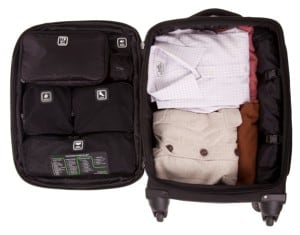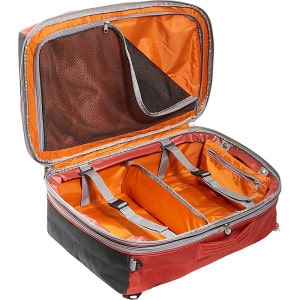Even a luggage junkie like me has had her share of suitcase mishaps. My favorite came while sprinting through Los Angeles International Airport when my nifty (and pricey) wheeled overnight bag lost a wheel. Well, not the entire wheel, just the outer rim, which had peeled off in pieces behind me. It was like having a flat while driving on the interstate, but with no tow truck to provide rescue. Fortunately, the bag was small enough I could lift it by the handles and lug it to the gate. The high-end manufacturer was so embarrassed by what had happened, the company replaced the entire wheel system without charge and asked me not to name names. I still love and use my little case, though when I’m on the hunt for a new piece of travel gear, I do scrutinize the wheels.

Buying luggage can be as nerve-wracking as buying a car. Do you want a low-cost, stripped-down model that simply gets you from point A to point B or do you need fancy features and shiny extras? A heavyweight that will stand up to any collision or something lighter that may dent easily? A lifetime warranty or no coverage once you “drive” it out of the store? Here are six ways to save during your next suitcase-shopping expedition.
Think ahead
“It all comes down to durability, strength and value,” says Peter Cobb, co-founder of online travel goods retailer, eBags. “Do you want a bag that will get you through the next trip or last five to 10 years?” A good bag, even by a lesser-known manufacturer can be had for about $150. “It’s worth it to pay a bit more for good construction vs. a bag that will easily rip,” he says.
Moderate-priced lines that are known to offer the most bang for the buck include Eagle Creek, Delsey, TravelPro and Antler. eBags even produces its own luggage line. Look for a manufacturer’s guarantee. For example, Briggs & Riley is known for its lifetime warranty. If anything ever goes wrong, say an airline damages your bag or a zipper simply stops zipping, Briggs & Riley will repair it, free of charge. Buy brands with at least five to 10 years of coverage.
Weight matters
With airlines charging for checked bags (and charging extra if they weigh more than 50 pounds), you need to dump old, heavy suitcases. Polycarbonate (hardside) luggage usually weighs the least and will protect the contents.
Look for a good grade of poly, because the cheap stuff may crack. Some polycarbonate carry-ons weigh as little as four pounds. Ballistic nylon material is cheaper, but usually heavier, though British-manufacturer it Luggage makes the “world’s lightest carry-on” at 2.8 pounds, with a 3.6 pound, four-wheel carry-on priced at $89.95.
Don’t fixate on flashy features
Ask yourself what you can and can’t live without. A waterproof zipper? An outside handle so you have more packing capability? Telescoping, adjustable handle? Sure four wheels, often called “spinners” make it easier to maneuver a suitcase with the option to push or pull. But they add both weight and about $30 or more to the bottom line. I’d rather my case have two solid wheels, than four that may self-destruct in transit.
What about a gazillion internal or external pockets? Most hardside luggage has few if any places to stash stuff, because a pouch can’t be “sewn” onto the plastic. That can be a real hassle if you have to open up the entire case to retrieve your laptop, favorite novel or in-flight stash of munchies.
Pack it well
Remember how hardside suitcases have few, if any, pockets? One way to compensate is to use packing cubes. These are lightweight sleeves or cube-shaped pouches designed to compress and hold a variety of clothing and gear neatly in your suitcase. In fact, cubes are the No. 1 seller on eBags. A three-piece eBags Packing Cubes set starts at $22.99 and is well worth the investment. I’m also a fan of Genius Pack, a tidy, multifunctional, 22-inch carry-on with designated compartments. The case includes a space that squishes your dirty laundry, freeing up more packing space, and integrates a portable mobile charger, mini-speakers, umbrella, packing checklist and more. Basically you can live out of it for $238.
Never pay retail
Like clothing and shoe manufacturers, luggage companies often change styles and colors. When collections change, prices drop. Look for in-store promotions and don’t be afraid to poke around to see if there are any leftover floor models the store will discount. Remember department stores such as Macy’s or Dillard’s. They don’t stock a wide variety of products, but I’ve seen top brands discounted as much as 60%.
If you live close enough, check factory outlets. At one in Denver, I found a Samsonite carry-on wheeled garment bag for $209.99 (retail $420), plus an extra 15% off that day. That same store carried discontinued styles from Briggs & Riley and Victorinox.
There’s value in buying online
According to Peter Cobb, eBags boasts 2.6 million customer reviews. So take some time to research brands and models. And though this will probably get me in trouble with my local luggage retailer, it’s OK to “kick the tires” and carefully examine suitcases in store, then buy them cheaper online. A good suitcase should fit you and your travel style. Pull it around the store. How does it maneuver? Lift it up onto a table. It is lighter or heavier than expected? Then do some comparison shopping online. You can find significant discounts, up to 60% or more, on sites such as Amazon and eBags.
Featured photo by FrameAngel/freedigitalphotos.net.
If you liked this article, you may also enjoy:
7 money-saving tips for buying (and not losing) new luggage
How to stretch your holiday travel budget




